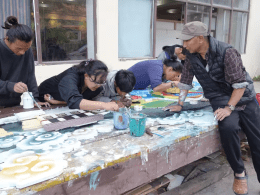In a renewed effort to revive Bhutan’s struggling orange industry, the government is banking on climate-resilient seedlings and improved orchard management practices to combat the twin threats of citrus greening disease and aging plantations.
During the National Assembly’s question hour on Friday, Agriculture and Livestock Minister Younten Phuntsho acknowledged the steep decline in orange production, particularly in Samtse district. Once a leading exporter of citrus fruits, Samtse’s annual orange exports have plummeted from over 500 truckloads to just 18.
The Dophuchen-Tading Member of Parliament, Ugyen Lama, voiced concern over the situation, saying many farmers had lost their only source of income and were left in despair.
“People have lost their sole source of income and are now in a hopeless situation,” said Lama. “What is the ministry doing to revive citrus production and uplift the community?”
Minister Phuntsho attributed the drop in yields primarily to citrus greening disease, first detected in Phuentshogling in 1992, and also noted that aging trees are contributing to the problem.
As part of the response, the ministry has included orange under its Million-Fruit-Tree Plantation Programme and is leveraging the Building Resilient Commercial Smallholder Agriculture (BRECSA) project. Currently, the BRECSA project is supporting orchard rehabilitation in Zhemgang, Trongsa, Sarpang, and Tsirang.
“We are also running a similar initiative in six eastern districts,” said the minister. “Through this, we are focusing on orchard management, disease prevention, and improving yields.”
To strengthen these efforts, the ministry is conducting research on nine varieties of oranges, aiming to identify those that are better suited to Bhutan’s changing climate and resistant to disease.
The possibility of shifting land use was also raised during the session. Shompangkha MP Tek Bahadur Rai suggested that farmers should be allowed to convert orchards into dry land if orange cultivation proves unviable.
“It is difficult to convert orchards to dry land officially,” Rai said. “But if permitted, it would allow people to grow high-yield crops or even construct houses.”
In response, Minister Phuntsho stated that any changes to land use would have to be reviewed in coordination with the National Land Commission, which governs land conversion policies.
The urgency of these measures is underscored by a 2020 study revealing that Bhutanese orange trees yield only about seven kilogrammes of fruit each on average—far below international standards of 30 to 50 kilogrammes per tree.
With citrus farming under pressure and rural livelihoods at stake, climate-resilient solutions and policy flexibility could hold the key to reviving an industry once at the heart of Bhutan’s agricultural economy.








